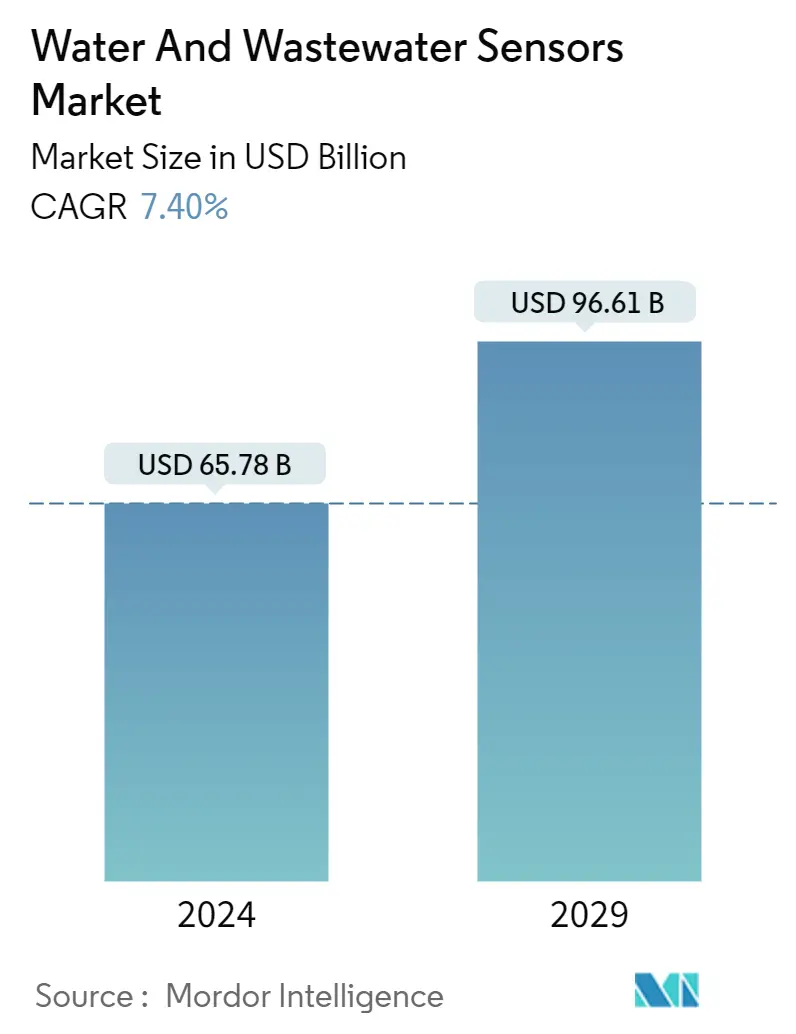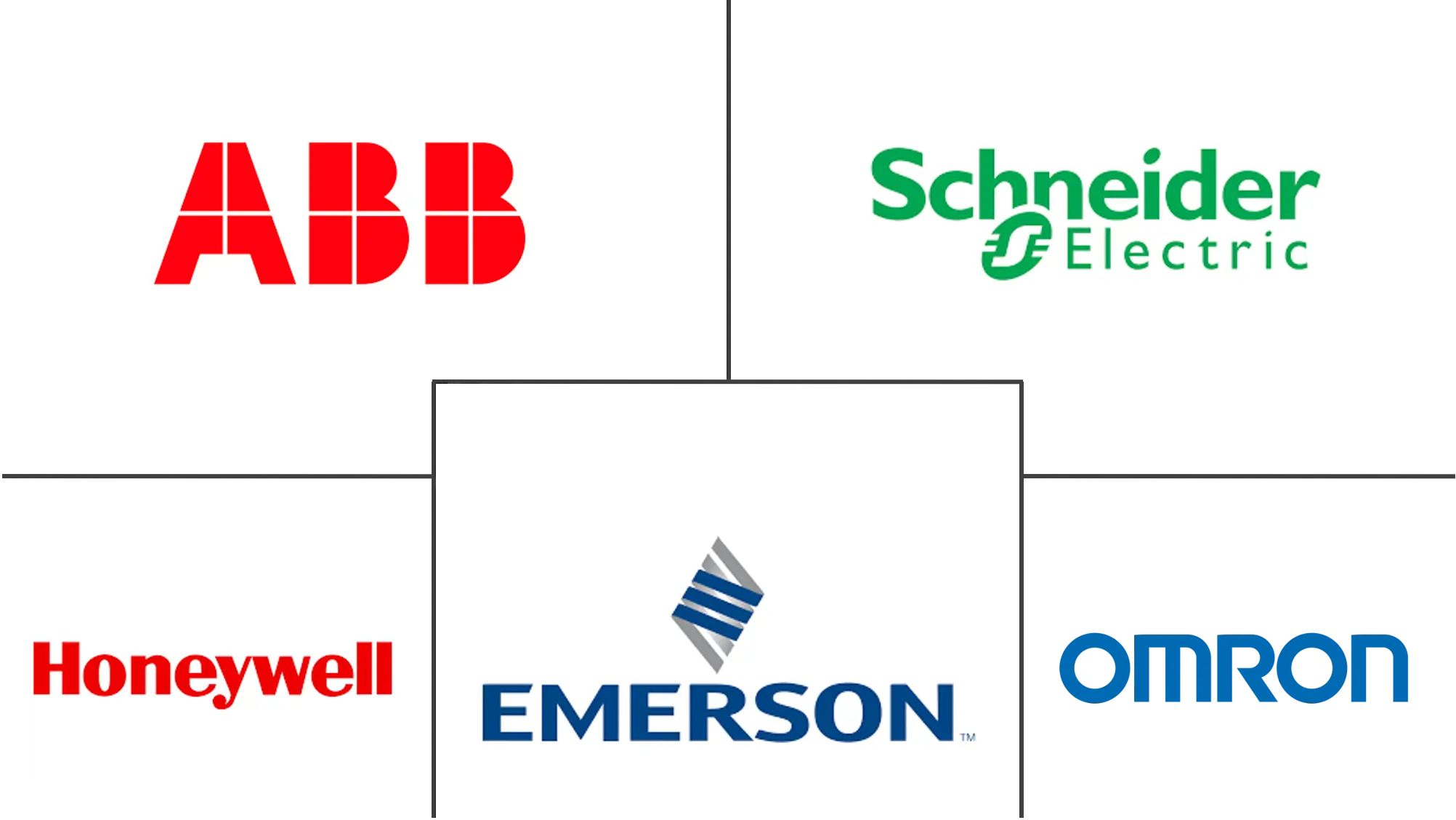Market Size of Water And Wastewater Sensors Industry

| Study Period | 2019 - 2029 |
| Market Size (2024) | USD 65.78 Billion |
| Market Size (2029) | USD 96.61 Billion |
| CAGR (2024 - 2029) | 7.40 % |
| Fastest Growing Market | Asia-Pacific |
| Largest Market | North America |
| Market Concentration | Low |
Major Players
*Disclaimer: Major Players sorted in no particular order |
Water and Wastewater Sensors Market Analysis
The Water And Wastewater Sensors Market size is estimated at USD 65.78 billion in 2024, and is expected to reach USD 96.61 billion by 2029, growing at a CAGR of 7.40% during the forecast period (2024-2029).
- Growing measurement of the rising level of water pollution and increasing government funding for controlling and monitoring pollution are key factors driving the market growth in the forecast period. Furthermore, the government of India is planning to invest INR 3.6 trillion (USD 50 billion) in the Jal Jeevan Mission, the government’s ambitious program to supply piped water to all households in the country, intent start in 2024.
- Increased demand for clean water due to industrialization, rising urbanization, and diminishing freshwater supplies are expected to enhance studied market demand. In August 2022, the US Department of Agriculture (USDA) announced a USD 75 million investment in critical infrastructure improvements to ensure thousands of rural people in Greenbrier County have clean drinking water and sanitary wastewater systems for years to come.
- Furthermore, according to the US Environmental Protection Agency, the Bipartisan Infrastructure Law delivers more than USD 50 billion to the Environmental Protection Agency (EPA) to improve the nation’s drinking water, wastewater, and stormwater infrastructure. Such investments in clean water projects may further drive the studied market demand.
- Moreover, in terms of changing or installing new pipelines, the rising number of infrastructure upgrades is expected to impact market growth positively. For instance, in November 2022, Southland Holdings, LLC announced that a subsidiary in its Civil segment, Oscar Renda Contracting, has been awarded a USD 59 million contract to construct a water pipeline project for the Eastern New Mexico Water Utility Authority.
- In addition, the United Nations Sustainable Development Goal 6 aims to ensure access to water and sanitation for all people across the globe by 2030. It is nudging governments to take steps in the right direction. Rising government initiatives to provide safe drinking water are anticipated to positively impact the growth of the water and wastewater sensors market in the forecast period.
- The high cost of water treatment plants led to limited penetration of water quality sensors in non-industrial applications may hinder the studied market growth in the forecast period. Additionally, a lack of awareness about water quality, especially in the rural areas of developing nations, is also hindering the development of the water and wastewater sensors market.
Water and Wastewater Sensors Industry Segmentation
Different sensors, including pH, conductivity, ORP, turbidity, and dissolved oxygen, shall be used to maintain water quality. In industrial terms, it's known as an analyzer. According to which water is treated for waste or bad water, those analyzers form the main section of the water treatment plant.
The water and wastewater sensors market is segmented by type (pH sensors, DO sensors, temperature sensors, turbidity sensors, and other types), application (municipalities, industrial wastewater treatment, and other applications), and geography (Europe, North America, Latin America, Asia-Pacific, and Middle East and Africa)
The market sizes and forecasts are provided in terms of value in USD for all the above segments.
| By Type | |
| pH Sensors | |
| DO Sensors | |
| Temperature Sensors | |
| Turbidity Sensors | |
| Other Types (ORP, Conductivity, etc.) |
| By Application | |
| Municipalities | |
| Industrial Wastewater Treatment |
| By Geography | |
| North America | |
| Europe | |
| Asia | |
| Australia and New Zealand |
Water And Wastewater Sensors Market Size Summary
The water and wastewater sensors market is poised for significant growth, driven by increasing concerns over water pollution and substantial government investments in infrastructure and clean water initiatives. The market is expected to expand as industrialization, urbanization, and the depletion of freshwater resources heighten the demand for effective water quality monitoring solutions. Government programs, such as India's Jal Jeevan Mission and the US Bipartisan Infrastructure Law, are set to bolster market growth by funding projects aimed at improving water supply and sanitation. Additionally, the United Nations' Sustainable Development Goal 6 is encouraging global efforts to ensure access to clean water, further propelling the market's expansion. However, challenges such as the high cost of water treatment facilities and limited awareness in rural areas of developing countries may impede market penetration.
The market landscape is characterized by a diverse array of players and a strong emphasis on innovation and strategic partnerships. Companies are actively developing advanced sensor technologies, such as pH sensors, to meet the growing demand in various applications, including industrial water treatment and aquaculture. Notable advancements, like HORIBA's Gel-filled Self-Cleaning pH Electrode and ANB Sensors' calibration-free pH monitoring solutions, highlight the industry's commitment to enhancing water quality management. The Asia-Pacific region, with its rising industrial water needs and government initiatives, is a key market area, while collaborations between institutions in India and Europe aim to address water quality challenges. Overall, the market is set to benefit from ongoing technological advancements and supportive government policies, despite facing some regional and economic hurdles.
Water And Wastewater Sensors Market Size - Table of Contents
-
1. MARKET INSIGHTS
-
1.1 Market Overview
-
1.2 Industry Value Chain Analysis
-
1.3 Industry Attractiveness - Porter's Five Forces Analysis
-
1.3.1 Threat of New Entrants
-
1.3.2 Bargaining Power of Buyers
-
1.3.3 Bargaining Power of Suppliers
-
1.3.4 Threat of Substitute Products
-
1.3.5 Intensity of Competitive Rivalry
-
-
1.4 Technology Snapshot
-
1.5 Impacts of Macro trends on the Market
-
-
2. MARKET SEGMENTATION
-
2.1 By Type
-
2.1.1 pH Sensors
-
2.1.2 DO Sensors
-
2.1.3 Temperature Sensors
-
2.1.4 Turbidity Sensors
-
2.1.5 Other Types (ORP, Conductivity, etc.)
-
-
2.2 By Application
-
2.2.1 Municipalities
-
2.2.2 Industrial Wastewater Treatment
-
-
2.3 By Geography
-
2.3.1 North America
-
2.3.2 Europe
-
2.3.3 Asia
-
2.3.4 Australia and New Zealand
-
-
Water And Wastewater Sensors Market Size FAQs
How big is the Water And Wastewater Sensors Market?
The Water And Wastewater Sensors Market size is expected to reach USD 65.78 billion in 2024 and grow at a CAGR of 7.40% to reach USD 96.61 billion by 2029.
What is the current Water And Wastewater Sensors Market size?
In 2024, the Water And Wastewater Sensors Market size is expected to reach USD 65.78 billion.

